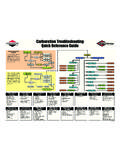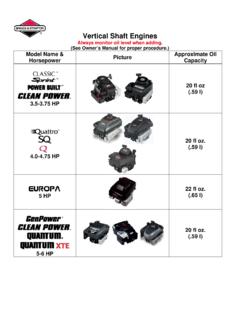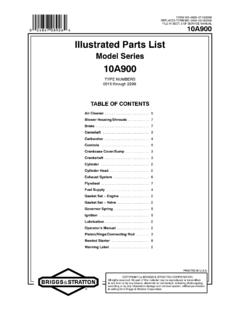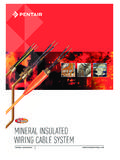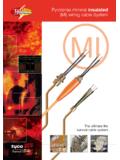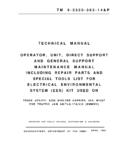Transcription of ELECTRICAL SYSTEM INFORMATION FOR LAWN GARDEN …
1 LAWN & GARDEN PRODUCTELECTRICAL106S 1612 ELECTRICALSYSTEMINFORMATIONFORLAWN&GARDE NPRODUCTLAWN & GARDEN PRODUCTELECTRICALS 161210720 & 22 BATTERY INFORMATIONGENERAL INFORMATION (COURTESY OF HAWKER ENERGY PRODUCTS INC.)The battery used on the 20 & 22 inch walk behind isa Sealed Lead Battery which utilizes cells made ofa pure lead tin material. These types of batteries areclassified as non spillable wet electric storagebatteries and may be shipped as such. (Figure 13)Overcharging and undercharging can both decreasebattery life. Undercharging is more detrimental to abattery and decreases battery life more quickly thanovercharging. When using the charger supplied withthe battery, charge for 12 16 hours after everymowing to maintain optimum battery Constant Volt Charger is recommended forHawker a general rule of thumb, charge the battery to105 110% of the capacity used on the discharge. Toguarantee a complete and adequate recharge, ampere hours (Ah) should be returned tothe battery for every 1 Ah that is is the major cause of battery deterioration.
2 Forevery 13 180 F increase above 770 F ambienttemperature, the expected life of the battery goesdown by 50%. As the temperature rises,electrochemical activity within the battery increasesand the life is sealed lead batteries are batteries of this type must be recycled inaccordance with local recycling the battery s Open Circuit Voltage drops Volts or below, it should be charged. If theOpen Circuit Voltage is allowed to drop to and V, permanent damage may occur tothe battery. If the voltage drops below V, then thebattery may not be able to be types of batteries use a gas recombinationprinciple. During the charging cycle, Oxygen andHydrogen are formed. The Oxygen, up to a point, isrecombined to form water at the negative 13: BATTERY FOR 20 & 22 Hydrogen gas generation is reduced by the use ofthe pure lead tin material. But, some Hydrogen willescape, especially in an overcharge situation.
3 So,DO NOT CHARGE in a closed container. Our batterycover is not considered a sealed the terminals of the battery are short circuited, anextremely high instantaneous current will begenerated. These large currents will cause seriousinjury or damage. DO NOT SHORT CIRCUIT THEBATTERIES ACROSS THE NEGATIVE ANDPOSITIVE of different capacities, age, or make shouldnot be mixed within the same battery should be charged prior to storage andcharged again before being put back into use. Thebattery may be stored with the unit. These batteriesare rated to 400 F and at that temperature it willretain its charge much better than at & GARDEN PRODUCTELECTRICAL108S 161220 & 22 BATTERY INFORMATION continuedREMOVAL/NORMAL RECHARGING1. Disconnect wiring harness. (Figure 14)2. Push quick release and remove battery Attach charger to battery. (Figure 15)4. Plug charger to an ELECTRICAL Charge for 12 16 Disconnect charger from outlet and Attach battery case to Connect wiring harness to : Do Not leave the charger connected tothe battery if the charger is not plugged to awall outlet.
4 The charger will drain the TEST PROCEDURE (COURTESY OFHAWKER ENERGY PRODUCTS INC.)Procedure:1. Disconnect battery from charger, wire harness,or any other circuit. If battery has just beencharged, voltage may be artificially inflated andshould be allowed to rest for at least 4 hours inorder for voltage to Check open circuit voltage (OVC) at theconnector. A fully charged battery should havea minimum OVC of volts. If reading fallsbelow this number, charge overnight with aknown reliable charger. (See NOTE below)3. Repeat Step #1 above, then re check OVC. Ifvoltage has not recovered at all from originalreading, replace battery. If voltage has increased,try to start the mower. An older battery may notreach volts, but still may start the mowerwith no Whether the battery is placed back into service orreplaced, advise the end user that the batteryshould always be charged after use.
5 Although itmay still start the mower, the energy used to startit needs to be replenished to keep the battery ata high state of ON Known reliable Charger : This refersto any charger that has a minimum ampsavailable and charges at a constant voltage ofbetween and volts. If the charger s outputis less than volts, it will not fully recharge thebattery. For constant volt chargers, there is nocurrent limit. A 6 amp or 10 amp charger or evenmore is acceptable to use, but a minimum of 1 ampis required if the battery is discharged quite a 14: BATTERY REMOVAL & INSTALLATIOND isconnectWiringHarnessPush QuickRelease &RemoveFIGURE 15: BATTERY CHARGINGTo WallOutletTo BatteryLeadFOR MORE INFORMATION ON BATTERIES,CONTACT:HAWKER ENERGY PRODUCTS North Ridgeview DriveWarrensburg, MO 64093 9301, USAT elephone:(660) 429 2165 Fax:(660) 429 6397 LAWN & GARDEN PRODUCTELECTRICALS 1612109 TRACTOR BATTERY INFORMATIONGENERAL INFORMATIONWARNING: Batteries produce explosivegases.
6 Keep cigarettes, flames and sparksaway from batteries at all times. Protectyour eyes at all times. Never lean over abattery when jump starting or performingother and replace any battery that has evidenceof cracks in the case or cover. If the battery is leaking,place the battery in a plastic bag and take to a properrecycling 16: DANGERS OF A BATTERYSHIELD EYESE xplosive Gasescan causeblindness orinjuryNOSS parksSFlamesSSmokingSULFURICACIDCan causeblindness orsevereburnsFLUSH EYESIMMEDIATELYWITH WATERGETMEDICALHELP FASTDANGER/POISONKEEP OUT OF THE REACH OF NOT TIP. KEEP VENT CAPS TIGHT AND NOT OPEN FLUSH COVER the Batteries Charging StateThere are two (2) types of wet cell batteries. (1)Maintenance Free and (2) Serviceable Batterieswhich have removable vent caps.(1) Maintenance Free Batteries are only free fromservicing in that you do not need to add water. Yet,the amount of acid or electrolyte may deplete due toexcessive heat or improper regulator settings.
7 Use aVoltmeter to check the Charging Status of thebattery. Re charge if necessary. Never open thesetypes of batteries.(2) Serviceable Batteries require maintenanceservice each year. To check to see if this type ofbattery is good, measure the Open Circuit Voltagewith a Voltmeter or take a Specific Gravity reading ofthe Electrolyte with a Hydrometer. If the circuitreading is below volts or the Specific Gravityreading is below SG, charge the battery. If theelectrolyte levels are too low for a Hydrometerreading add water to the : If water is added to a battery, make sureyou run the engine to charge the battery so theacid and water will mix. This is especiallyimportant in cold weather as the water in thebattery can the battery cells with clear, odorless drinkingwater. Distilled water is preferred, especially if thewater in your area has a high iron content. Fill eachcell until the level is to the bottom of the vent well in(Figure 17).
8 DO NOT OVERFILL. Overfilling abattery will cause the acid to bubble out the vent capscorrode the metal part and damage the belts. CUT AWAY VIEWVent WellCorrect BatteryAcid LevelFIGURE 17: CHECK FLUID LEVEL IN BATTERYLoad Testing The BatteryFollow up the hydrometer or open circuit voltagetest with an adjustable load test to make sure thebattery has enough ELECTRICAL charge. Follow theinstructions on the tester. If the battery keeps aminimum voltage of for 30 seconds while underload, the battery is in good condition. If not, rechargeand test again. If it fails a second time replace & GARDEN PRODUCTELECTRICAL110S 1612 TRACTOR BATTERY INFORMATION continuedBattery Charging TipsSCharge the battery if the circuit reading is volts or the Specific Gravity reading froma hydrometer is below SG or the load testis below vent caps in place when charging NOT CHARGE FOR MORE THAN the hydrometer readings or voltage readingshave not improved after two hours, stopcharging the battery.
9 Any further charging willdamage the a battery will not come to full charge ( SGor Volts), replace the the battery case feels hot, reduce ortemporarily stop the charging try to charge a frozen battery. Let thebattery warm up to room temperature trickle charge a battery for more than48 Starting The BatteryAccidents happen! Always shield your eyes and facewhen working around batteries. Make sure the ventcaps are pushed in completely and cover with adamp cloth. Use a good quality set of booster cablesand proceed as the RED cable to the positive (+) postof the weak the other end of the same red cable tothe positive (+) post of a good the BLACK cable to the negative ( )post of the good , connect the other end of the BLACK cableto a GROUNDED metal part of the engine oftractor both engines and remove the cables inreverse order from above. Remove and discardthe damp cloths from each 18: JUMP STARTING HOOK UPWeak BatteryTo GroundGood BatteryBATTERY VOLTAGESTATE OF & GARDEN PRODUCTELECTRICALS 1612111 TESTING THE SOLENOIDWhen the engine of a riding mower will not turn over, there are a few possible reasons for this outside of theengine itself.
10 One reason is the battery does not have sufficient charge (refer to pages 54 55 for charginginformation). Another reason is a problem with the wiring Harness/Operator Presence SYSTEM (refer to pages56 64 for troubleshooting INFORMATION ). Finally, the last possible reason is a bad solenoid. The test procedurebelow will determine if the solenoid is good or the solenoid, disconnect the cable lead thatruns from the solenoid to the a mutli meter, check the battery forsufficient charge. It should read between open circuit voltage. If the reading isless than , then charge the battery beforeproceeding. For the solenoid to work properly,it needs a minimum of during the battery has sufficient charge, then checkthe solenoid s coil resistance. To check theresistance, disconnect the lead that goes to theprimary terminal. Check the resistancebetween the primary terminal and the base ofthe solenoid. If there is no resistance betweenthose two points, then the coil of the solenoid iseither burnt or one or both coil leads are this point, the solenoid should be there is resistance between the coils, then seeif the solenoid will click.




